Here are three photos of the home at Bella Vista in which I lived for three years starting in December of 1981. On the door closeup you can see Barrymore's crest with the coiled serpent over the JB.
Enjoy!
Robert



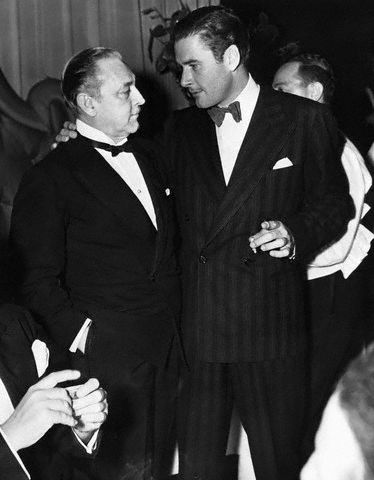
— Robert
Here are three photos of the home at Bella Vista in which I lived for three years starting in December of 1981. On the door closeup you can see Barrymore's crest with the coiled serpent over the JB.
Enjoy!
Robert




— Robert
Here are three photos I took of Mulholland Farm on April 10, 1981 (before my October, 1983 tour of the house when Rick Nelson lived there). The first photo shows the house from Mulholland Drive, the second photo shows the stable and part of the casino, which is shown fully in the third photo. How sad the house no longer exists.
Enjoy.
Robert



— Robert
You will see this in the bar of the Hotel Nacional Havana:
January 2008
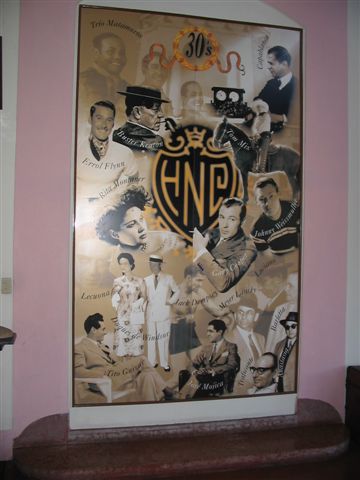
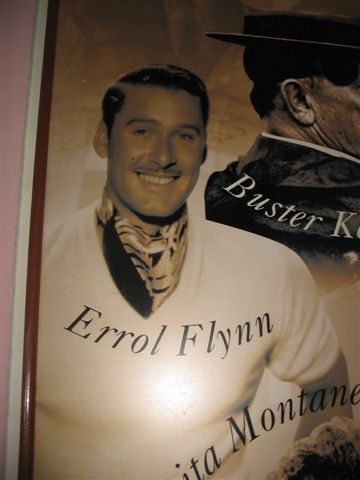 A closer look!
A closer look!
And if you wander further…
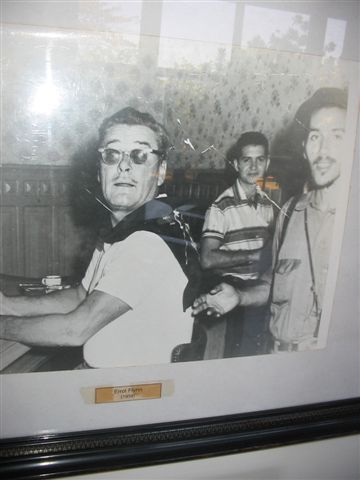
Photos courtesy of David our Canadian Reader who visited Havana and was pleasantly surprised to find these items in the Hotel bar…
David writes:
Some of what I wrote about my trip to cuba and the visit to Hemingway's mansion…
Hemingway's mansion 15 Km south of Havana has beeen recently restored and its beautiful. Errol Flynn, and Ava Gardner were among the many visitors to Hemingways' home in the country which has been a museum since shortly after he died when everythng was left as it was when he walked out the door. We were told that he had wanted it to become a library and that it was Fidel's idea to make it into a Museum. Hem's widow, Mary Walsh, consented.
Visitors to the museum – amazing to see even if you have outgrown him or don't like him – are not allowed inside but the doors and windows are open except when it rains. Female attendents keep watch one or two to a room. If you stick even your chin over the sill or brocade barrier, you will be politley scolded. 'Chin' one said to me. They don't speak much English but know body parts!
The one-story colonial house sits on a small hill. There is a pool and they now have Hem's restored sports fishing boat, Pillar. Hemingway had left it to his captain when he died and who only died himself a few years ago.
One story has it that Ava Gardner went down to the pool and swam naked. Hemingway, up in the tower he built, spied her through his telescope. Hemingways wife, Mary Walsh, did not think much of that spectacle, poor woman, and when she got wind of it, went down and gathered up Ava's Robe, forcing her to walk back to the house naked.
Looking in through the guest room window you can see two twin beds, a phonograph, a tall book case. I tried to imange some of his guests, Gary Cooper, for example, sleeping in what for them would have been humble digs. (Most probably did not stay but chauffered back to the Hotel Nacional? The bar at the Hotel nacional, is like a hall of fame with photos and posters by decade of the illustrious visitors.
There is not much that is glamorous in the streets of Havana so this place is a nice retreat. The Hotel is on the architectural tour we took. It was popular with movie stars Gary Cooper, Errol Flynn, Johny Wiesmueller, and Buster Keaton to name a few. Seaside there is a lawn with an ocean view and breeze and comfortable dark wicker chairs.
I had some time to write in my diary on the bus trip from Havana to Trinidad, on the opposite side of the Island. I tried my hand at writing linked Haiku which you will recall is a three-line poem where the first and third lines have 5 syllables and the middle 7.
I added to the nude bathing story other details I had heard. For example, when guests arrived Hem rang a bell and fired a small cannon which sits just inside the front door now. I rang the bell but did not include it in the Haiku.
I also imagined that Errol visited Hemingway on his last visit to the Island in 1959 shortly after the revolutution and when Errol, and probably Hemingway too, would have been suffering from Scirrocis of the liver. Hemingway may also have been sufferreing from paranoia by then as well.


— David DeWitt
By DAVE KEHR
Published: August 25, 2008
Errol Flynn Westerns Collection Review:
John Ford’s “Stagecoach,” the legend goes, rescued the adult western from the B-movie category into which it had fallen during the first years of the Depression, making it safe again for big budgets and big stars.
But that is an honor rightfully shared with Errol Flynn. This unruly Australian-born star lent his immense popularity to three hugely successful westerns in a row, beginning with “Dodge City,” released in April 1939, a month after “Stagecoach,” and continuing in 1940 with “Virginia City” and “Santa Fe Trail.” (“Stagecoach” was itself preceded by Henry King’s Technicolor “Jesse James,” released in January 1939, starring Tyrone Power.)
These Flynn westerns paired him with his Warner Brothers screen sweetheart, Olivia de Havilland, and were directed by Michael Curtiz, a Hungarian immigrant. Curtiz’s minimal level of engagement with the genre is suggested by the command he is said to have issued during the shooting of “The Charge of the Light Brigade”: “Bring on the empty horses!” — meaning the riderless mounts.
Apparently it wouldn’t do to have a bunch of foreign interlopers behind the rebirth of this most American of American genres. So Flynn’s role in the history of the western has largely been forgotten, despite the fact that he went on to appear in five more, including Raoul Walsh’s 1941 classic “They Died With Their Boots On.” But now that Warner Home Video has brought together four superbly mastered Flynn westerns — “Montana,” “Rocky Mountain,” “San Antonio” and “Virginia City” — in “Errol Flynn: The Warner Brothers Western Collection,” the moment is ripe for reappraisal.
On one level Flynn’s transition from swashbucklers to westerns makes perfect sense: after “Captain Blood” (1935) and “The Adventures of Robin Hood” (1938), his screen character had grown to such epic proportions that it required a correspondingly epic stage. And after he did his bit for the British Empire, the American West was just about the only other arena that could contain him.
But on another level, as Flynn is said to have observed, his accent and manner were too Continental to fit smoothly into the imaginary space of the American frontier. The screenplays for his westerns — many written by Robert Buckner — continually come up with ingenious explanations for the hero’s curious courtliness and exotic speech patterns: in “Dodge City” he’s an Irish soldier of fortune who finds himself herding cows in Kansas; “Montana” (1950) just throws in the towel and identifies Flynn as an Australian sheep farmer (among the many professions Flynn practiced) who dreams of bringing these white, woolly creatures to western cattle country.
But who could accept Flynn, with his pencil moustache and rakish smile, as a humble cowpoke in a 10-gallon hat? Warner Brothers got around this issue mainly through costuming, dressing Flynn in long frock coats that set him apart from the bandannas and bluejeans of the supporting players. With their slimmer profile, these costumes evoked the tailored three-piece suits of the 1930s far more than the mail-order dry goods of the 1880s. Wide-brimmed, flat-topped hats completed the ensemble, adding an ineffable touch of urbanity (and even a hint of zoot suit flair). This look established Flynn as a man apart, an aristocrat passing through the West without necessarily being a part of it.
The four films in the new set are interesting but of uneven quality. (Not included are “Dodge City” and “They Died With Their Boots On,” which were part of Warner Brothers’ “Errol Flynn Signature Collection: Volume 1”; “Santa Fe Trail,” which has fallen into the public domain and is available in several dubious versions; and “Silver River,” a fine Raoul Walsh film from 1948.)
“Virginia City” casts Flynn as a Union officer who escapes from a Confederate prison and is sent west on a secret mission to intercept a shipment of silver intended for the depleted coffers of the Confederacy. Its oddest element is Humphrey Bogart, pre-stardom, as an outlaw whose accent wavers unpredictably between French and Spanish. As a director, Curtiz never seemed happier than when he was staging elaborate tracking shots through crowded cafes (including a famous one, a couple of years later, under Bogart’s management). The gigantic saloon set of “Virginia City” gives Curtiz several opportunities to indulge himself, as Flynn and his opposite number, a Confederate officer played by Randolph Scott, compete for the affections of the star attraction, a singer played by Miriam Hopkins.
“San Antonio” (1945) repeats the formula, although this time in Technicolor and with the regal Alexis Smith as the singer. The director is David Butler, best known for his musical comedies (“Calamity Jane,” 1953); not surprisingly, he emphasizes the comedy (in the hands of S. Z. Sakall and Florence Bates) and musical elements. (Smith is a vision in white satin and rhinestones, performing “Some Sunday Morning.”)
With a brief running time of 76 minutes, “Montana” has the feel of a troubled production. Both Vincent Sherman and Raoul Walsh did some directing work on the project, which was ultimately signed by Ray Enright. Near the end of his Warner Brothers contract, Flynn was starting to show signs of his drug and alcohol addictions, and the film, despite some handsome Technicolor interiors photographed by Karl Freund, is choppy and lifeless.
But Flynn’s final western, the little-known “Rocky Mountain,” turns out to be a small discovery. Its black-and-white photography and restricted scale suggest the rapidly shrinking budgets that accompanied the late-’40s collapse of the studio system, yet both of these elements work to the benefit of this taut little tale of a Confederate raiding party, led by Flynn, pinned down on a mountaintop by Union troops and Shoshone Indians. The director, William Keighley, was Warner Brothers’ specialist in adapting Broadway stage comedies (“The Man Who Came to Dinner,” 1942), and he makes the most of the confined setting, drawing sharp characterizations from a supporting cast that includes Guinn Williams, Slim Pickens (in his first film) and Howard Petrie, as well as Patrice Wymore (soon to become the third and last Mrs. Flynn) as the troubling female presence.
Like several westerns of the period, “Rocky Mountain” is defined by a very unwestern sense of claustrophobia and entrapment. With the slightest push, the picture would be a film noir, and its climax is appropriately somber. Much of the credit must go to the cinematographer, Ted McCord, a great landscape artist (“The Treasure of the Sierra Madre”) who was also fluent in the high-contrast style of studio noir (“Flamingo Road,” “Young Man With a Horn”). The western, in its infinite richness, continues to yield surprises. (Warner Home Video, $49.98, Now On Sale for $34.99, not rated)
Thanks to Tom
— David DeWitt
by Steve Hayes
Thanks for this tip from Jack Marino…
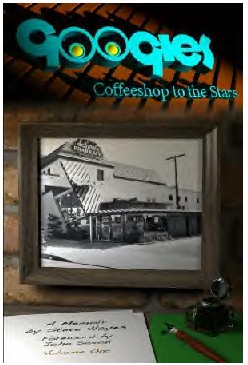
From the website:
Ever wonder what it was like back in the forties and fifties, mingling with famous movie stars on the Sunset Strip; to ride beside James Dean in his Porsche Speedster, zipping around the curves of Mulholland Drive; to stay at Errol Flynn's house and sleep in the bedroom with the infamous hole in the mirrored ceiling; share a secret with Marilyn Monroe; act in a movie with Alan Ladd or Lana Turner; race motorcycles with Clark Gable on Ventura Boulevard; paint Rita Hayworth's house; be invited to tea by James Mason; go to the Hollywood Bowl with Jayne Mansfield and Louella Parsons; hang out with Flynn and countless other stars at the sordid Garden of Allah?
Well, I did all those things and more, much more. As a fledgling actor, part-time house painter, parking attendant, “snoop” for the Fred Otash Detective Agency, and manager of Googie's, a celebrated coffee shop next to Schwab's drug store, I was in the catbird seat, privy to all the gossip, brawls and excitement that nightly took place at the Mocambo, Ciro's, The Players, Crescendo, Villa Nova and other glamorous night spots along the Strip. Known as the “playground of the stars,” never a night went by on the Sunset Strip that one didn't rub elbows with the likes of Frank Sinatra, Ava Gardner, Duke Wayne, Lana Turner, Rita Hayworth and numerous other high profile celebrities.
It's a fascinating era that has disappeared forever.
And I was there in the thick of it.
And now you can be, too.
Because I've written it all down, exactly as it was…
— David DeWitt
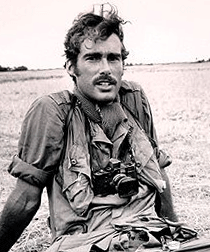
Before turning to journalism, Flynn, the only son of Errol Flynn and French actress Lili Damita, worked as an actor for several years. He appeared in a sequel to “Captain Blood,” in which his father starred.
Millennium and Ralph Hemecker's Mythic Pictures are developing “Flynn.” Hemecker, a prolific TV writer who created the TNT movie “Witchblade,” will direct; he is writing the screenplay with Perry Deane Young, who wrote the book on which the movie will be based.
Reuters/Hollywood Reporter
Article courtesy of Peach
— David DeWitt
From TV.com…
Errol Flynn on ARTHUR MURRAY PARTY
Show Category: Variety Shows
Length: 30 Minutes
During its run from 1950 through 1960, Arthur Murray Party ran on all four TV networks (ABC, Dumont, CBS and NBC).
Arthur Murray
Role: Host
Kathryn Murray
Role: Hostess
Episode Number: 225 Season Num: 9
Scheduled guests:
Connie Francis (singer) – “Stupid Cupid.”
Helen Hayes (actress known as the “First Lady of the American Theatre”).
Errol Flynn (actor)
Anne Baxter (actress)
Sydney Chaplin
Aired: October 27, 1958
Anybody have this one, yet?
— David DeWitt
Highly recommended work by one of our own EF Blog Authors, Stephen Youngkin.
The Lost One: A Life of Peter Lorre
— David DeWitt
If you love movies, and classic actors – you must check out Stephen Youngkin's bio of Peter Lorre! …its extraordinary!
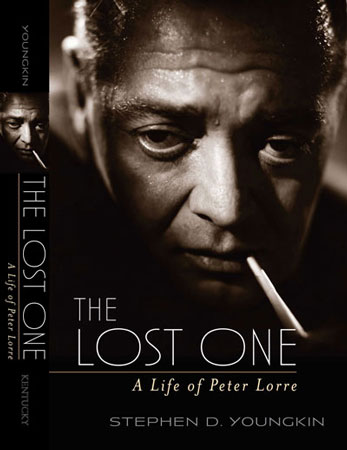
The Lost One: A Life of Peter Lorre
More info at PeterLorreBook.com…
— David DeWitt